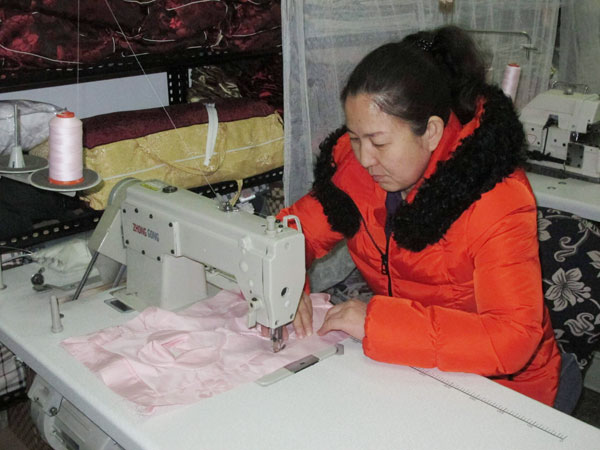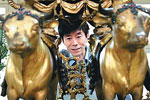
 'Taken 2' grabs movie box office crown
'Taken 2' grabs movie box office crown
 Rihanna's 'Diamonds' tops UK pop chart
Rihanna's 'Diamonds' tops UK pop chart
 Fans get look at vintage Rolling Stones
Fans get look at vintage Rolling Stones
 Celebrities attend Power of Women event
Celebrities attend Power of Women event
 Ang Lee breaks 'every rule' to make unlikely new Life of Pi film
Ang Lee breaks 'every rule' to make unlikely new Life of Pi film
 Rihanna almost thrown out of nightclub
Rihanna almost thrown out of nightclub
 'Dark Knight' wins weekend box office
'Dark Knight' wins weekend box office
 'Total Recall' stars gather in Beverly Hills
'Total Recall' stars gather in Beverly Hills
'Xiaozhuang Pillows' of Qing Dynasty inherited
Updated: 2013-02-05 09:43
By Wang Kaihao (China Daily)
|
||||||||
 |
|
Mou Chunling preserves the declining tradition of making Mongolian-style ear pillows in Tongliao. Photos by Wang Kaihao / China Daily |
Low-pressure pillows have provided a good night's sleep for Genghis Khan's soldiers and modern-day Inner Mongolians. One needlework artist is determined to preserve the tradition, Wang Kaihao reports from Tongliao.
|
 |
|
 |
The workshop in the noisy wholesale market is no more than 60 square meters.
It looks a little messy, with 10 sewing machines almost buried under piles of half-finished pillows. Also, the pillows look a little unusual. They are covered in delicate cloth and they have holes on each side.
Mou Chunling, a 47-year-old woman of the Mongolian ethnic group in Tongliao, Inner Mongolia autonomous region, supervises the making of these "ear pillows", so called because the holes are designed to protect the ear from pressure during sleep.
According to local folklore in Tongliao, the ear pillow can be traced back to the era of Genghis Khan (1162-1227), when it was favored by sentry soldiers. Later it became a must-have daily necessity of the royal Manchu family in the Qing Dynasty (1644-1911). But the tradition has declined over the past century.
Mou got into the pillow business in 2007, a trade which she jokingly says she "inherited by blood." Her ancestors were tailors for the Mongol nobles in the time of empress dowager Xiaozhuang (1613-1688), a Mongol concubine in the Qing Dynasty who was born on the Horqin grassland (in today's Tongliao).
The concubine is said to be the one who took the ear pillow to royal Manchu families, and the fashion later spread among the rich nationwide.
When Mou's family got together for her mother's 80th birthday party in 2007, her aunt, who is the fifth generation of ear-pillow makers in her family, made two small pieces as gifts and complained that no one would inherit the skill.
Mou then decided to try it herself, though she knew little about this long-embedded art in her family history except for seeing a few examples in her childhood.
Mou says that sewing had once saved her in a very difficult time earlier in her life.
A native of Bairin Left Bannerin in Inner Mongolia's city of Chifeng, Mou had to quit her teaching job in 1991 to join her husband, who had a new job in Tongliao.
Most Viewed
Editor's Picks

|

|

|

|

|

|
Today's Top News
Boston bombing suspect reported cornered on boat
7.0-magnitude quake hits Sichuan
Cross-talk artist helps to spread the word
'Green' awareness levels drop in Beijing
Palace Museum spruces up
First couple on Time's list of most influential
H7N9 flu transmission studied
Trading channels 'need to broaden'
US Weekly

|

|










